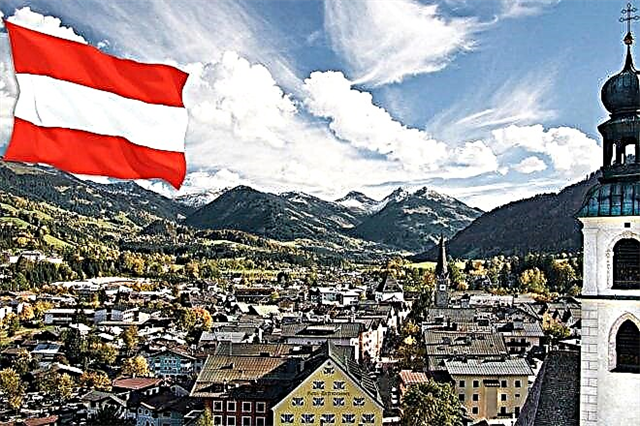Calm, measured and prosperous Austria attracts not only tourists. The standard of living and the average salary in Austria has long made it a dream come true for many migrant workers. However, the desire to move to one of the prosperous European countries often stumbles upon quite predictable obstacles: lack of knowledge of the language, an unconfirmed diploma and problems with obtaining a work visa. And yet this does not mean that foreigners cannot find a decent place here with an acceptable income.

Economic indicators
Prior to the onset of the COVID-19 pandemic, the Austrian labor market was favorable against the EU average. It is difficult to assess the situation now. But, since the search for options for labor migration is not a quick matter, it makes sense to study the legislative aspects and options for employment.
The legislative basis for working in the Republic of Austria is made up of several regulations at once:
- Labor Constitution Arbeitsverfassungsgesetz - ArbVG.
- General Federal Law Arbeitszeitgesetz (AZG) - Regulates working hours (normal hours and overtime).
- Separate act of employment as service personnel and home helpers Hausgehilfen- und Hausangestelltengesetz;
- Ausländerbeschäftigungsgesetz - AuslBG - regulates the employment of foreigners.
Rating of professions and in-demand specialists
Based on data from the Austrian Employment Service (AMS), Austrian employers experience the greatest shortage of highly qualified specialists in industry, trade and in the provision of medical services. This is reflected in the salaries that employers promise to future employees: the salary of a doctor in Austria with five years of work experience is comparable to the monthly income of a civil engineer or software developer. Highly qualified nurses and teachers also receive no less.
In addition, the labor market shows a shortage of technical workers, construction workers, drivers, office workers and seasonal workers in agriculture and tourism.
Despite this, Austrians are in no hurry to take up vacant positions in the service sector or work specialties. Gaps in the ranks of lower-level personnel (nannies, cleaners, house helpers, waiters, nurses and salespeople) are often filled by foreigners from Eastern Europe and the former USSR.
For those who cannot boast of a prestigious education and intend to change jobs or undergo professional re-profiling, AMS has created the Karrierekompass portal.
Features of determining the level of salaries
 In Austria, as in many other countries, labor discrimination on any of the generally accepted grounds - gender, race, religion or political opinion - is prohibited. And yet there are a number of factors that significantly affect the size of the salary of an individual specialist:
In Austria, as in many other countries, labor discrimination on any of the generally accepted grounds - gender, race, religion or political opinion - is prohibited. And yet there are a number of factors that significantly affect the size of the salary of an individual specialist:
- Level of education and practical qualifications.
- Scarcity of the chosen specialty - employers are ready to pay 4,000 euros or more per month for professionals who are especially in demand.
- Age - the preference is still given to workers under 50, and in rapidly developing technological areas the age limit is even lower.
- Territory of the employer. For example, wages in Vienna are higher than in other states.
- Gender factor. Employers are more willing to trust men to do responsible work.
- Citizenship - priority is given to citizens of Austria or one of the EU member states, people from other countries are treated with less confidence.
Minimum wage
The main law governing the position of workers and their employers is the Austrian Labor Constitution (Arbeitsverfassungsgesetz - ArbVG). In particular, it says that the minimum wage rate at the federal level is set only for those groups of hired specialists (industries) where:
- it is impossible to conclude a collective agreement;
- collective agreements do not set minimum rates.
At the same time, even the established tariffs should be revised if they are less than federal or lower than the rates approved in the contracts of other companies operating in related economic activities.
In 2021, the minimum rates for domestic workers were again revised (the law on fixing rates Festsetzung des Mindestlohntarifs für im Haushalt Beschäftigte für Österreich):
| Federal states | Minimum wage in Austria and additional payments, euros per hour | |||
|---|---|---|---|---|
| Home helpers | Supplements | Technical staff | Supplements | |
| Burgenland | 9,55 | Festsetzung des Mindestlohntarifs für Hausbesorgerinnen und Hausbesorger für Burgenland | 11,11 | Festsetzung des Mindestlohntarifs für die Betreuung und Bedienung von Anlagen und Einrichtungen auf Liegenschaften für Burgenland |
| Carinthia | 9,73 | Festsetzung des Mindestlohntarifs für Hausbesorgerinnen und Hausbesorger für Kärnten | 10,36 | Festsetzung des Mindestlohntarifs für die Betreuung und Bedienung von Anlagen und Einrichtungen auf Liegenschaften für Kärnten |
| Lower austria | 9,54 | Festsetzung des Mindestlohntarifs für Hausbesorgerinnen und Hausbesorger für Niederösterreich | 14,89 | Festsetzung des Mindestlohntarifs für die Betreuung und Bedienung von Anlagen und Einrichtungen auf Liegenschaften für Niederösterreich |
| Upper Austria | 10,70 | Festsetzung des Mindestlohntarifs für Hausbesorgerinnen und Hausbesorger für Oberösterreich | 13,30 | Festsetzung des Mindestlohntarifs für die Betreuung und Bedienung von Anlagen und Einrichtungen auf Liegenschaften für Oberösterreich |
| Salzburg | 9,68 | Festsetzung des Mindestlohntarifs für Hausbesorgerinnen und Hausbesorger für Salzburg | 12,22 | Festsetzung des Mindestlohntarifs für die Betreuung und Bedienung von Anlagen und Einrichtungen auf Liegenschaften für Salzburg |
| Styria | 9,89 | Festsetzung des Mindestlohntarifs für Hausbesorgerinnen und Hausbesorger für Steiermark | 16,23 | Festsetzung des Mindestlohntarifs für die Betreuung und Bedienung von Anlagen und Einrichtungen auf Liegenschaften für Steiermark |
| Tyrol | 9,76 | Festsetzung des Mindestlohntarifs für Hausbesorgerinnen und Hausbesorger für Tirol | 14,78 | Festsetzung des Mindestlohntarifs für die Betreuung und Bedienung von Anlagen und Einrichtungen auf Liegenschaften für Tirol |
| Vorarlberg | 9,87 | Festsetzung des Mindestlohntarifs für Hausbesorgerinnen und Hausbesorger für Vorarlberg | 14,79 | Festsetzung des Mindestlohntarifs für die Betreuung und Bedienung von Anlagen und Einrichtungen auf Liegenschaften für Vorarlberg |
| Vein | 9,72 | Festsetzung des Mindestlohntarifs für Hausbesorgerinnen und Hausbesorger für Wien | 15,05 | Festsetzung des Mindestlohntarifs für die Betreuung und Bedienung von Anlagen und Einrichtungen auf Liegenschaften für Wien |
Average earnings
The average salary in Austria can inspire potential migrants who want to receive much higher wages for their professional knowledge and skills than at home. However, foreigners need to know that, according to the working hours law, Austrian employers want to receive from the employee for this salary:
- 48 hours of weekly employment (on average, calculated over the last 17 weeks) - as the norm for working hours;
- 60 hours of employment per week without additional payment for overtime and prior agreement with the employee - in the form of the maximum allowable workload (cannot be regular);
- 10 hours a day as a normal working day, with the option to extend it to 12 hours at no additional cost if this occurs within the weekly average.
At the same time, by law and collective agreements by industry, workers are guaranteed two additional monthly salaries per year: 13th as payment for summer holidays and 14th for Christmas.
Austrian lawmakers did not begin to restrict business and fix the minimum wage for most professions at the national level.
However, taking into account the regulatory recommendations and provisions of collective agreements for individual industries, the following situation with the income of employees has formed in the country.
| Index | Average income in Austria, euros / month |
|---|---|
| Minimum wage (for unskilled labor) | 1 660 |
| average salary | 2 689 |
| Income of highly qualified specialists | 3 590 |
Income level by profession
The salary rating in Austria by profession will not come as a surprise to those who already have a rough idea of what kind of specialists can be highly paid in a country with a developed economy.
| Name of the profession | Average earnings, EUR / month | Salary range, EUR / month |
|---|---|---|
| Financial analyst | 3017 | 2 449—3 944 |
| Lawyer | 2702 | 2 194—3 532 |
| General practitioner / surgeon | 3222 | 2 615—4 210 |
| Dentist | 2785 | 2 170—3 819 |
| Inpatient hospital nurse | 3222 | 2 615—4 210 |
| Nurse (private) | 2629 | 2 130—3 523 |
| School teacher | 2944 | 2 390—3 849 |
| University professor | 3327 | 2 593—4 564 |
| Educator | 2184 | 1 938—2 622 |
| Programmer | 3272 | 2 626—4 340 |
| Accountant | 2931 | 2 338—3 866 |
| Energy Engineer | 2641 | 2 059—3 623 |
| Civil engineer | 3059 | 2 456—4 060 |
| Police officer | 2369 | 2 045—2 847 |
| Secretary | 2659 | 2 295—3 194 |
| Salesman | 1985 | 1 730—2 369 |
| Public transport driver | 1898 | 1 638—2 281 |
| Waiter | 1730 | 1 493—2 078 |
| Nanny | 2184 | 1 938—2 622 |
| Electrician | 2366 | 2 037—2 856 |
| Plumber | 2300 | 1 981—2 778 |
| Auto Mechanic | 2269 | 1 954—2 740 |
| Builder | 2089 | 1 803—2 510 |
| Miner | 2283 | 1 971—2 743 |
| Repair worker | 2044 | 1 763—2 454 |
| Handyman at construction site | 2089 | 1 803—2 510 |
The principles of taxation of salaries It is also necessary to understand that the level of income also depends on the scale of the business. For example, the salary of an engineer in a large company will be 20-25% higher than in a small private firm.
After the tax reform of 2015-2016, the approach to the calculation of income tax from the earnings of employees was changed. From 2021, personal income tax is levied on a progressive six-tier scale.
| Annual income range, EUR | Interest rate limit |
|---|---|
| up to 11,000 | 0 |
| from 11,000 to 18,000 | 25 |
| from 18,000 to 31,000 | 35 |
| from 31,000 to 60,000 | 42 |
| from 60,000 to 90,000 | 48 |
| from 90,000 to 1,000,000 | 50 |
| over 1,000,000 (the rate was applied only up to and including 2020) | 55 |
The amount of social security contributions is determined by the general law on social insurance (including pension) - Art. 51 Allgemeines Sozialversicherungsgesetz, ASVG. It also fixes the division of interest rates payable from the employer's funds and in the form of deduction from the employee's gross salary.
| Contribution type | Employer Share (SV-DGA) | Employee share (SV-DNA) |
|---|---|---|
| Formation of the severance pay fund upon dismissal (Selbständigenvorsorge) | 0.0153 | - |
| Medical (Krankenversicherung) | 0.0378 | 0.0387 |
| Accident and Occupational Risk Insurance (Unfallversicherung) | 0.012 | - |
| For unemployment (Arbeitslosenversicherung) | 0.03 | 0—3 % |
| Pension insurance (Pensionsversicherung) | 12,55 % | 0.1025 |
To facilitate calculations, the Ministry of Finance has developed an online gross-net salary calculator showing the amount of deductions taking into account the Family plus tax bonuses: for example, a deduction for a child under 18 in the amount of 1,500 euros per year or a monthly deduction for each child in the amount of 58.40 euros , for example.
Living wage in the country
Official employment in Austria promises decent pay for those who are employed in positions that do not provide for the performance of highly qualified duties:
- a worker's salary can range from 1,570 to 1,890 euros / month;
- real income of a professional with an average qualification level - 2 130-2 640 euros / month;
- employees with a high level of professional skills earn 2,940-3,750 euros / month.
At the same time, the living wage in Austria in 2021 allows a family with two children to pay their bills in full, even if one of the parents is employed part-time.
| Cost category | Typical family: one or two children and two parents | Standard family: two children and two working parents | Per adult living alone |
|---|---|---|---|
| Nutrition | 650—845 | 745—965 | 185—240 |
| Lodging | 880—995 | 880—995 | 445—505 |
| Transport | 61—91 | 61—91 | 30—45 |
| Medical care | 28—77 | 28—77 | 7—19 |
| Education | 27—92 | 27—92 | - |
| Other | 82—105 | 87—110 | 33—40 |
| Total cost | 1 728—2 205 | 1 828—2 330 | 700—849 |
Employment statistics
 According to Eurostat, in the second quarter of 2021, the unemployment rate in Austria was only 4.5%. At the same time, among young people (they are considered Austrians from 15 to 24 years old), 8.4% remained without employment, and only 3.3% of older people (aged 55 to 64) looking for work.
According to Eurostat, in the second quarter of 2021, the unemployment rate in Austria was only 4.5%. At the same time, among young people (they are considered Austrians from 15 to 24 years old), 8.4% remained without employment, and only 3.3% of older people (aged 55 to 64) looking for work.
However, according to the estimates of the National Bureau of Statistics AMS online, the estimated unemployment rate was slightly higher: in September 2021 it was 6.6%: 6.8 - among women, 6.5% - among men. At the same time, the highest percentage of unemployed was observed in Vienna and Carinthia, and the lowest in Tyrol and Salzburg.
Among foreigners who obtained a work visa in Austria (it is almost impossible to work illegally here), the unemployment rate is slightly higher: in September 2021, the average percentage was 9.4%: 11.3 among women and 8.2% among men.
Some optimism is encouraged by the fact that the number of unemployed residents of other countries has been gradually decreasing. The Austrian employment service records that the lion's share (67%) of the registered unemployed are in the active age from 25 to 49 years.
Foreigners officially staying in the country can claim the same level of social protection against unemployment as Austrian citizens (the conditions for social insurance and payment of benefits are set out in the federal law Arbeitslosenversicherungsgesetz 1977, AlVG). The amount of state aid depends on the employee's salary in Austria over the past 24 months. You can calculate unemployment benefits using a calculator.
Conclusion
The level of salaries in Austria is not considered the highest in Europe, but the country certainly falls into the top five in terms of attractiveness. It should also be borne in mind that the country can offer comfortable living conditions, and the authorities are ready to ensure the safety of the entire population.











